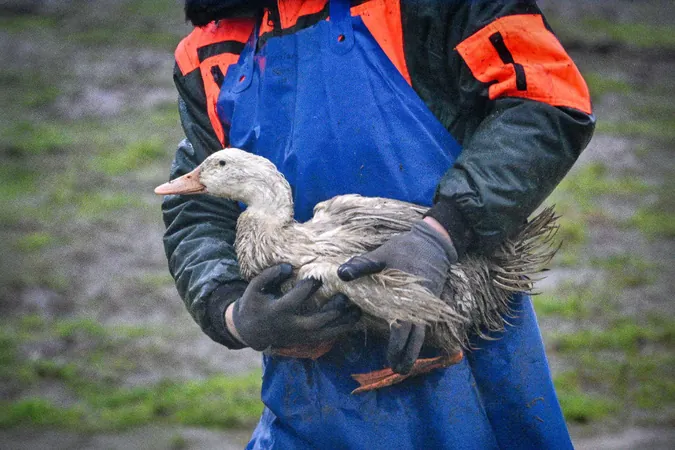
Unraveling the Surge of Bird Flu: Climate Change at the Core of the Crisis?
2025-01-12
Author: Li
In a dramatic turn of events, Skomer Island off the coast of Wales has witnessed a harrowing loss among its resident guillemot population. Once, nearly 100,000 of these seabirds occupied the island, but escalating threats such as oil pollution and increasing tanker traffic had already devastated their numbers since World War II. After an inspiring recovery to about 30,000 birds by 2022, disaster struck in the summer of 2023 when bird flu claimed around 15,000 guillemots. Timothy Birkhead, a dedicated researcher at the University of Sheffield, highlights the guillemot's critical ecological role, warning that their decline has ripple effects throughout the island's ecosystem.
The current wave of avian influenza, particularly the H5N1 strain, has emerged as a formidable global threat since its inception in 2020, affecting numerous species across the animal kingdom. This includes not just birds, but also marine mammals like elephant seals and polar bears, with millions of wild birds lost and significant impacts on poultry and dairy industries in the U.S. Recent reports indicate a concerning first human death attributed to bird flu in Louisiana, raising alarms among health experts.
One of the pressing questions surrounding this crisis is why the bird flu outbreak is intensifying now, despite the virus being identifiable since the mid-1990s. Climate change appears to be a key factor. While establishing a direct correlation is complex, various studies indicate that a warming planet influences natural disasters, migratory behaviors, nesting seasons, and habitats of avian populations, thereby facilitating the spread of avian flu.
Dr. Damien Joly, a wildlife biologist from the University of Saskatchewan, underscores how climate instability complicates patterns of bird movement, introducing them to new agricultural areas and increasing likelihoods of contact with the virus. Compounding this issue is the proliferation of extreme weather events, often linked to climate change. For instance, the arrival of bird flu in North America coincided with significant storms and shifts in environmental conditions.
Skomer Island faced a particularly dire situation, where a food scarcity prior to the bird flu outbreak—triggered by severe storms and record high sea temperatures—left guillemots more vulnerable. Dr. Erin Sorrell from Johns Hopkins indicates that a confluence of such environmental stressors can exacerbate disease spread, creating a "perfect storm" for the virus to flourish.
Migration patterns are also shifting due to warmer temperatures, urging birds to linger longer on breeding grounds—an environment ripe for high virus transmission, as pointed out by Dr. Claire Teitelbaum, a researcher focusing on wildlife diseases.
The infamous Qinghai Lake case in China illustrates how bird flu can jump continents, with a mutating virus traveling from its wintering grounds and leading to outbreaks across Eurasia and into Northern Africa—fuelled by climate-induced habitat changes.
As human activities continue to encroach on traditional migratory routes and habitats for birds, the risk of zoonotic diseases, which can leap from wildlife to humans, is magnified. Approximately 70% of pathogens infecting humans originate from wildlife, and as habitats are disrupted, opportunities for these viruses to transfer to agricultural and human populations grow.
Despite assurances from the Centers for Disease Control and Prevention (CDC) regarding low human infection risks, the increasing spillover into other species remains troubling. Experts stress that the more the H5N1 virus circulates among hosts, the higher the chances it could become more dangerous through processes like viral reassortment.
Efforts to manage this burgeoning crisis include the U.S. Department of Agriculture's $824 million funding for surveillance of wild bird populations, underscoring the importance of monitoring wildlife to stave off future outbreaks. As Joly aptly summarizes, proactive surveillance of wildlife is far cheaper and more effective than trying to manage outbreaks in the aftermath.
In the face of intertwining challenges like climate change and pandemics, it's clear that how we approach wildlife management and public health can have profound implications for both animal and human populations. The fight against the avian flu may very well depend on understanding and addressing the broader environmental and ecological changes at play.

 Brasil (PT)
Brasil (PT)
 Canada (EN)
Canada (EN)
 Chile (ES)
Chile (ES)
 Česko (CS)
Česko (CS)
 대한민국 (KO)
대한민국 (KO)
 España (ES)
España (ES)
 France (FR)
France (FR)
 Hong Kong (EN)
Hong Kong (EN)
 Italia (IT)
Italia (IT)
 日本 (JA)
日本 (JA)
 Magyarország (HU)
Magyarország (HU)
 Norge (NO)
Norge (NO)
 Polska (PL)
Polska (PL)
 Schweiz (DE)
Schweiz (DE)
 Singapore (EN)
Singapore (EN)
 Sverige (SV)
Sverige (SV)
 Suomi (FI)
Suomi (FI)
 Türkiye (TR)
Türkiye (TR)
 الإمارات العربية المتحدة (AR)
الإمارات العربية المتحدة (AR)